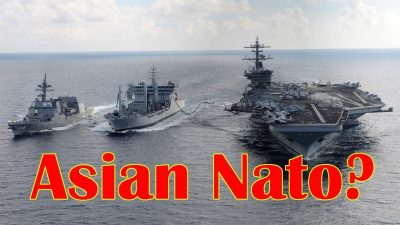US Wants to Convert QUAD into “Asian NATO”
Quadrilateral Security Dialogue” involving four countries - the US, Japan, India and Australia

Speaking last week at the US-India Strategic Partnership Forum, US Deputy Defense Secretary Stephen Biegun said that the US wants the defence relations with India, Japan and Australia – known as “the QUAD” – to resemble something more closely to the North Atlantic Treaty Organisation (NATO). QUAD is an acronym for Quadrilateral Security Dialogue” involving four countries – the US, Japan, India and Australia. The idea of unifying four of some of the most important countries in the Indo-Pacific region was launched during the first term of Japanese Prime Minister Shinzo Abe. That was in 2007. After that, the idea was forgotten for 10 years. By 2017, US President Donald Trump revived it when he started promoting the concept of the Indo-Pacific Strategy to prevent Chinese dominance in the region. QUAD played a leading role in the realization of this concept.
Biegun’s statement reveals that Washington’s goal is to get the four countries and others in the Indo-Pacific region to become a bulwark against “a potential challenge from China” and “to create a critical mass around the shared values and interests of those parties in a manner that attracts more countries in the Indo-Pacific and even from around the world … ultimately to align in a more structured manner.”
“The Indo-Pacific region is actually lacking in strong multilateral structures,” he said. “They don‘t have anything of the fortitude of NATO or the European Union. The strongest institutions in Asia oftentimes are not, I think, not inclusive enough and so … there is certainly an invitation there at some point to formalise a structure like this. Remember even NATO started with relatively modest expectations and a number of countries [initially] chose neutrality over NATO membership.”
Many politicians in the region are wary of these American ideas as it is clearly directed towards China. The Americans do not hide this motive either. In addition, Southeast Asian countries are not receptive to the idea of a military bloc in the region. The White House is striving to form a military bloc in Asia-Pacific, but establishing military cooperation corresponding with each country in the QUAD is not enough. Responsibility to each other is needed and the transformation of the entire region into an area of responsibility of the new organization is what has to be created if they hope to oppose China. This ambition will not be done with just existing US military bases in Okinawa and Australia, but will have to ultimately expand the network of US bases across the Indo-Pacific region if they hope to contain China’s growing influence.
When NATO was established in Europe in 1949, 12 countries joined and nothing was mentioned in the legal documents about the Soviet Union. The socialist countries of Eastern Europe then quickly became the main rival of NATO. Currently NATO has 30 members and the bloc’s border are directly on Russia’s. Even with the collapse of the Soviet Union, NATO still orchestrated and headed the breakup of Yugoslavia and then the downfall of long time Libyan ruler Muammar Gaddafi.
The question then becomes whether Indo-Pacific people want such a similar organization in their region that can very easily bring war and destruction.
The US, which currently has a fierce conflict with China, certainly wants to strengthen its strategic positioning by creating a coalition of states wanting to resist China’s rise. Therefore, the US Department of Defense hopes that some Southeast Asian countries, mainly those that have territorial disputes with China, like Vietnam and the Philippines, will join the QUAD, contributing financially and materially to the overall military structure. And then, as is the case in Europe, “Asian NATO” could become a tool to enact American interests in the region.
As was the case with NATO in Europe, the national armies of coalition members had to buy weapons made by the US. Therefore, the US military industrial complex will strongly support the idea of establishing an “Asian NATO.” This would present vast opportunities to the American military industry as countries that previously bought Russian weapons, like India, will have to completely refurbish. But in terms of priority, of course, is the desire to curb a growing China, meaning that the refurbishment of weapons will become secondary.
It is unlikely that the QUAD will be successful in converting into an “Asian NATO” against China as such a bloc would need greater support than just Australia, India and Japan. Without the support of massive Southeast Asian countries like Indonesia and Thailand, the “Asian NATO” will not be able to contain the rise of China. Such an alliance would be heavily dependent on India to match China’s manpower and capabilities, but they fall short as China has already begun to infrastructurally develop and become a mainstay of the economies of India’s neighbors, most notably Pakistan, Nepal, Bangladesh and Sri Lanka, thereby themselves containing India. Without the help of Southeast Asia, the QUAD cannot oppose China despite Washington’s hopes.
*
Note to readers: please click the share buttons above or below. Forward this article to your email lists. Crosspost on your blog site, internet forums. etc.
This article was originally published on InfoBrics.
Paul Antonopoulos is an independent geopolitical analyst.
Featured image is from InfoBrics

